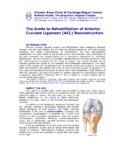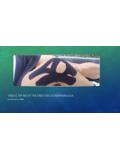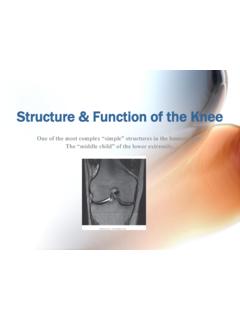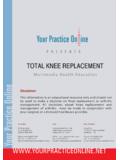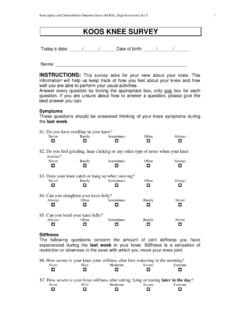Transcription of Knee Cryo/Cuff
1 knee Cryo/Cuff . knee cold and compression dressing (11A, 11B, 11C). The Aircast Cryo/Cuff combines focal compression with cold to provide optimal control of swelling, edema, hematoma, hemarthrosis, and pain. Simplicity of design and ease of operation makes it ideal for the ER, post-op, training room and home. The knee Cryo/Cuff has four parts: cuff surrounds the knee with pressurized ice water. Cooler holds enough water and ice for 6 to 8 hours of cryotherapy. Insulation Disk helps keep water and ice cold. Tube exchanges the water between cooler and cuff . CLINICAL EXPERIENCE. Post-operative experience with the knee Cryo/Cuff indicates hemarthrosis formation can be minimized and pain reduced by early and extended use of the Cryo/Cuff compression dressing.
2 2,4 In a study of post-op pain medication, use of the Cryo/Cuff was compared with continuous crushed ice, and with Hot Ice In both comparisons knee Cryo/Cuff patients required significantly less oral and injectable narcotic analgesics. Schro der, P ssler found that Cold-compression treatment led to less post- operative swelling of the knee joint, early return to full ROM, lower pain scores, lower consumption of analgesics, and faster return of function. 1. FREQUENCY OF USE. The length of use and frequency of use of the Cryo/Cuff are de- termined by the healthcare professional depending on individual patient's needs. CONTRAINDICATIONS. Cryotherapy should not be used on persons with Raynaud's or other vasospastic disease, cold hypersensitivity, decreased skin sensitivity, or compromised local circulation.
3 CARE. After use, completely drain water from cuff , tube, and cooler. (To drain tube, elevate tube while pressing tip of quick-disconnect.). Store cooler with top off to allow drying. Periodically clean cuff , tube, and cooler using a few ounces of liquid soap added to hot water in cooler. Recycle soap/water mixture between cooler and cuff a few times, then repeat with warm water only. Rinse com- pletely. LATEX REFERENCES. All Aircast products are latex-free. 1. Schro der D, P ssler HH: Combination of cold and compression after knee surgery. knee Surg, Sports Traumatol, Arthroscopy 93: 1 8, 1994. WARRANTY POLICY 2. Shelbourne KD: Post-surgical use of the Cryo/Cuff knee Compression Dressing, Satisfaction Aircast will provide prompt refund for any product that does not satisfy Protocol.
4 Indianapolis, Methodist Sports Medicine Center, 1989. the physician for any reason whatsoever. 3. Shelbourne KD, Rubinstein RA, McCarroll JR, et al: Postoperative Cryotherapy for the knee in ACL Reconstructive Surgery. Orthopaedics International Edition 2:2, March/. Durability Aircast will provide replacement parts for any Cryo/Cuff that becomes April 1994. unserviceable for any reason for a period of one year from date of sale provided the 4. Shelbourne KD, Wilckens JH: Current Concepts in Anterior Cruciate Ligament Rehabili- worn part is returned for analysis. tation. Orthopedic Review 19: 957 964, Nov 1990. knee Cryo/Cuff (11A, 11B, 11C). Instructions: Quick-disconnect Prepare cooler Secure Connect blue tube to cooler.
5 Add water to line inside cooler, then add top strap ice. For 6 to 8 hour treatment, add ice to top of cooler. Lay the insulation disk on top of ice. Attach cooler lid snugly. Allow 5 minutes with occa- sional shaking to chill water. Apply the EMPTY cuff Secure Fig. 1. Lay cuff on front of knee and secure the top strap, snug but not tight. bottom strap Adjust front opening so cuff conforms to slightly flexed knee (Fig. 1) . knee cap should appear through opening. Secure bottom strap loosely do not stretch the elastic. During continuous passive motion therapy (CPM) the bottom strap should be very loose. Secure front strap opening Fill cuff Connect blue tube to cuff . Open air vent on cooler lid and raise cooler Air vent (open).
6 No more than 15 inches (38 cm) above the cuff (Fig. 2). (If the cooler is raised more than 15 inches (38 cm), the cuff will increase in volume and weight.) Hold raised cooler for about 30 seconds while cuff fills. Close air vent on cooler lid. If not using an Aircast AutoChill System, the cooler can now be disconnected from cuff by pressing the metal tab on the quick-disconnect while cooler is raised. Rechill water At first, rechill the water in the cuff after 15 or 30 minutes, then once an hour or as needed. Reconnect the blue tube to cuff , lower the cooler below cuff , and the warmed water will drain from the cuff into the cooler. Allow a minute or two for the water to mix with the ice and rechill, then raise the cooler and repeat the filling process (see step 3).
7 The AutoChill system can be used with the Cryo/Cuff to automatically recycle the water from cooler to cuff (contact Aircast Customer Ser- vice for more information). Fig. 2. CAUTION. Do not use an elastic wrap in conjunction with the Cryo/Cuff . Dressings used under the Cryo/Cuff should be applied lightly. Patient's skin should be observed frequently due to individual sensitivity and susceptibility to cold. When filling the Cryo/Cuff , do not raise the cooler higher than 15 inches (38 cm) above the cuff to avoid excessive pressure. Reduce pressure with any sense of discomfort, numbness or tingling of the limb. Box 709. The Cryo/Cuff is designed for single patient use only and may be used on the same patient for the length Summit, NJ/USA 07902-0709.
8 (800) 526-8785. of treatment. The device should be cleaned if it is used on the same patient for an extended period of (908) 273-6349. time (see Care for cleaning information). Federal law restricts this device to sale by or on the order of a licensed healthcare professional. R 4/1/03. 11A100R. 1122. US PATENTS: 5,170,783 5,230,335 5,277,695 5,314,455 5,413,142 AND OTHER PATENTS PENDING.



